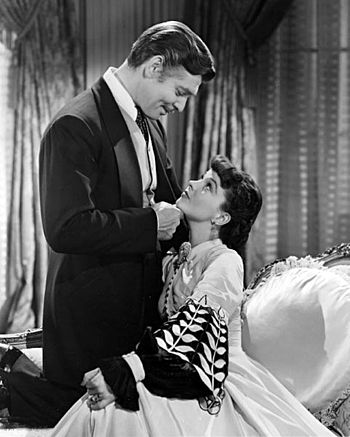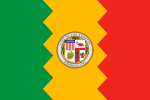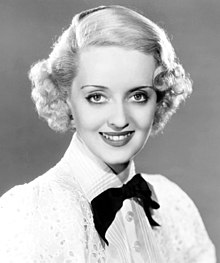Portal:Greater Los Angeles
The Greater Los Angeles Portal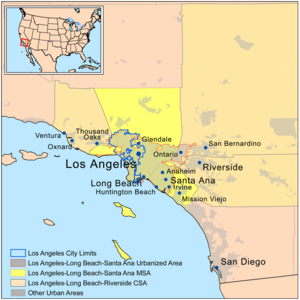 Greater Los Angeles is the most populous metropolitan area in the U.S. state of California, encompassing five counties in Southern California extending from Ventura County in the west to San Bernardino County and Riverside County in the east, with the City of Los Angeles and Los Angeles County at its center, and Orange County to the southeast. The Los Angeles–Anaheim–Riverside combined statistical area (CSA) covers 33,954 square miles (87,940 km2), making it the largest metropolitan region in the United States by land area. The contiguous urban area is 2,281 square miles (5,910 km2), whereas the remainder mostly consists of mountain and desert areas. With an estimated population of over 18.3 million (U.S. Census Bureau, 2023), it is the second-largest metropolitan area in the country, behind New York, as well as one of the largest megacities in the world. In addition to being the nexus of the global entertainment industry, including films, television, and recorded music, Greater Los Angeles is also an important center of international trade, education, media, business, tourism, technology, and sports. It is the third-largest metropolitan area by nominal GDP in the world with an economy exceeding $1 trillion in output, behind New York City and Tokyo. There are three contiguous component urban areas in Greater Los Angeles: the Inland Empire, which can be broadly defined as Riverside and San Bernardino counties; the Ventura/Oxnard metropolitan area (Ventura County); and the Los Angeles metropolitan area (also known as Metropolitan Los Angeles or Metro LA) consisting of Los Angeles and Orange counties only. The Census Bureau designates the latter as the Los Angeles–Long Beach–Anaheim metropolitan statistical area (MSA), the fourth largest metropolitan area in the western hemisphere and the second-largest metropolitan area in the United States, by population of 13 million as of the 2020 U.S. census. It has a total area of 4,850 square miles (12,561 km2). Although San Diego–Tijuana borders the Greater Los Angeles area at San Clemente and Temecula, it is not part of it as the two urban areas are not geographically contiguous due to the presence of Camp Pendleton. However, both form part of the Southern California Megalopolis which extends into Tijuana, Baja California, Mexico. (Full article...) Selected article -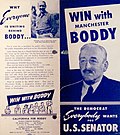 The Los Angeles Daily News (originally the Los Angeles Illustrated Daily News), often referred to simply as the Daily News, was a newspaper published from 1923 to 1954. It was operated through most of its existence by Manchester Boddy. The publication has no connection with the current newspaper of the same name. The Daily News was founded in 1923 by the young Cornelius Vanderbilt IV as the first of several newspapers he wanted to manage. After quickly going bankrupt, it was sold to Boddy, a businessman with no newspaper experience. Boddy was able to make the newspaper succeed, and it remained profitable through the 1930s and 1940s, after it took a mainstream Democratic perspective. The newspaper began a steep decline in the late 1940s and early 1950s. In 1950, Boddy ran in both the Democratic and Republican primaries for the United States Senate. Boddy finished a distant second in both primaries, and lost interest in the newspaper. He sold his interest in the paper in 1952, and publication ceased in December 1954, when the business was sold to the Chandler family, who merged it with their publication, the Los Angeles Mirror. Did You Know -
August 2014 Selected imageWikiProject
Related PortalsSelected biography -Ruth Elizabeth "Bette" Davis (/ˈbɛti/; April 5, 1908 – October 6, 1989) was an American actress of film, television, and theater. Regarded as one of the greatest actresses in Hollywood history, she was noted for her willingness to play unsympathetic, sardonic characters and was known for her performances in a range of film genres, from contemporary crime melodramas to historical and period films and occasional comedies, although her greatest successes were her roles in romantic dramas. She won the Academy Award for Best Actress twice, was the first person to accrue ten Academy Award nominations (and one write-in) for acting, and was the first woman to receive a Lifetime Achievement Award from the American Film Institute. In 1999, Davis was placed second on the American Film Institute's list of the greatest female stars of classic Hollywood cinema. After appearing in Broadway plays, Davis moved to Hollywood in 1930, but her early films for Universal Studios were unsuccessful. She joined Warner Bros. in 1932 and had her critical breakthrough playing a vulgar waitress in Of Human Bondage (1934). Contentiously, she was not among the three nominees for the Academy Award for Best Actress that year, and she won it the following year for her performance in Dangerous (1935). In 1936, due to poor film offers, she attempted to free herself from her contract, and although she lost a well-publicized legal case, it marked the beginning of the most successful period of her career. Until the late 1940s, she was one of American cinema's most celebrated leading ladies. She was praised for her role in Marked Woman (1937) and won a second Academy Award for her portrayal of a strong-willed 1850s southern belle in Jezebel (1938), the first of five consecutive years in which she received a Best Actress nomination; the others for Dark Victory (1939), The Letter (1940), The Little Foxes (1941), and Now, Voyager (1942). (Full article...) Regions, major cities and districtsRegions
Cities
Cities by countyTopicsCategoriesSelect [►] to view subcategories
Greater Los Angeles
Los Angeles County, California
Orange County, California
Ventura County, California
WikimediaThe following Wikimedia Foundation sister projects provide more on this subject:
Discover Wikipedia using portals |

